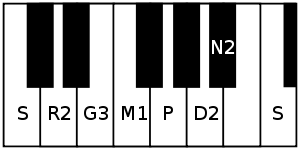Yadukulakamboji
| Carnatic music |
|---|
| Concepts |
| Compositions |
| Instruments |
|
Yadukulakamboji or Yadukulakambodi (yadukulakāmbhōji) is a rāgam in Carnatic music (musical scale of South Indian classical music). It is a janya rāgam (derived scale) from the 28th melakarta scale Harikambhoji, and is sometimes spelled as Yadukulakambhoji or Yadukulakambhodi. It is a janya scale, as it does not have all the seven swaras (musical notes) in the ascending scale. It is a combination of the pentatonic scale Shuddha Saveri and the sampurna raga scale Harikambhoji.[1][2]
Structure and Lakshana


Yadukulakamboji is an asymmetric rāgam that does not contain gandharam and nishadam in the ascending scale. It is an audava-sampurna rāgam (or owdava rāgam, meaning pentatonic ascending scale).[1][2] Its ārohaṇa-avarohaṇa structure (ascending and descending scale) is as follows:
The notes used in this scale are shadjam, chathusruthi rishabham, shuddha madhyamam, panchamam and sadharana dhaivatam in ascending scale, with kaisiki nishadham and antara gandharam included in descending scale. For the details of the notations and terms, see swaras in Carnatic music.
Popular compositions
There are many compositions set to Yadukulakamboji rāgam. Here are some popular kritis composed in this ragam.
- Hecharikagerara and Sri Rama raghurama composed by Tyagaraja
- Divakara tanujam and Tyagrajam bhajare by Muthuswami Dikshitar
- Paramakripa sagari by G. N. Balasubramaniam
- Kalaith thookki nindradum by Marimutthu Pillai
Related rāgams
This section covers the theoretical and scientific aspect of this rāgam.
Scale similarities
- Shuddha Saveri has a symmetric pentatonic scale, with the notes same as the ascending scale of Yadukulakamboji. Its ārohaṇa-avarohaṇa structure is S R2 M1 P D2 S : S D2 P M1 R2 S
- Kedaragaula is a rāgam which has the kaisiki nishadham in ascending scale in place of the sadharana dhaivatam. Its ārohaṇa-avarohaṇa structure is S R2 M1 P N2 S : S N2 D2 N2 P M1 G3 R2 S
References
- ↑ 1.0 1.1 Ragas in Carnatic music by Dr. S. Bhagyalekshmy, Pub. 1990, CBH Publications
- ↑ 2.0 2.1 Raganidhi by P. Subba Rao, Pub. 1964, The Music Academy of Madras
| ||||||||||||||||||||